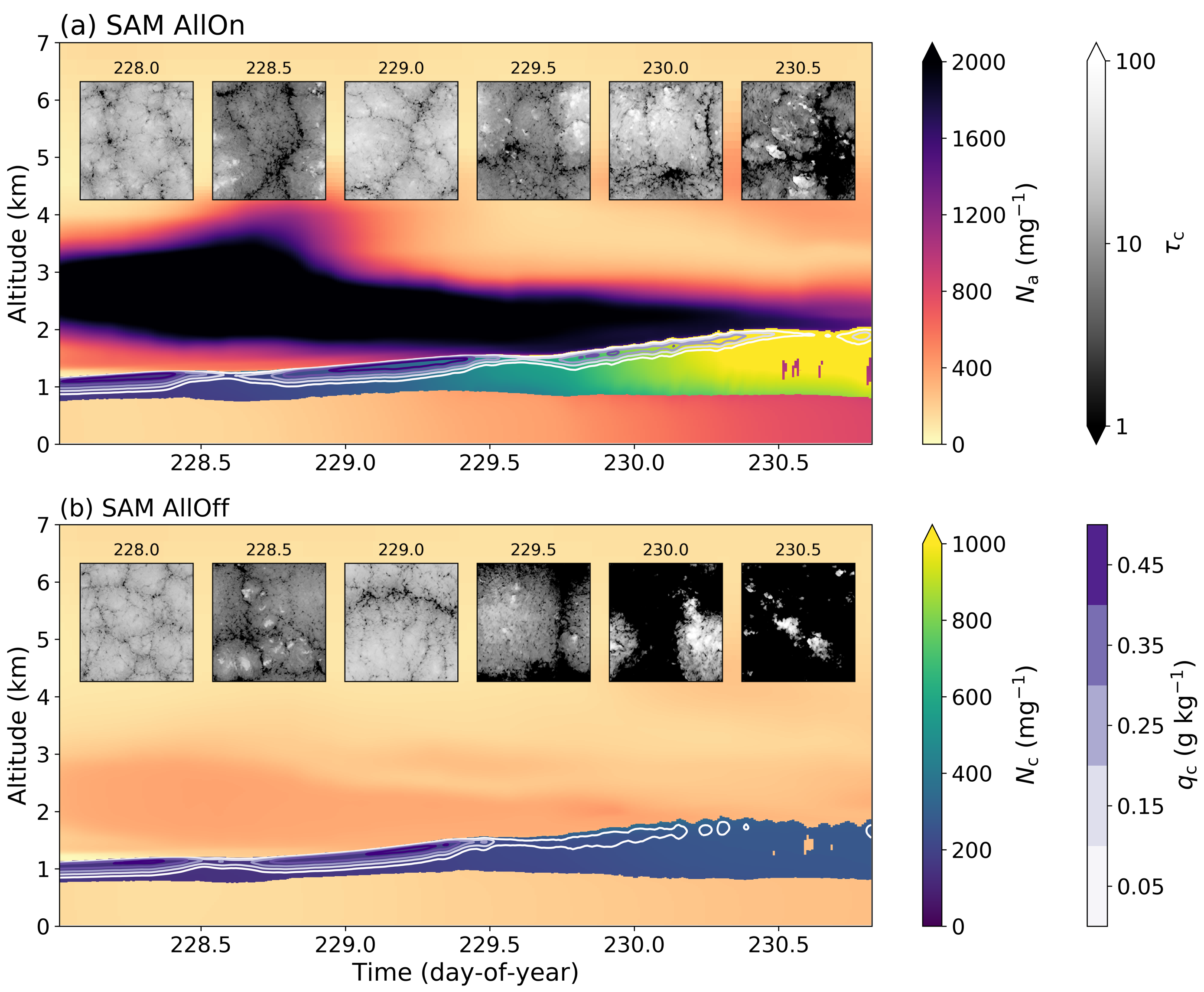Cloud adjustments from large-scale smoke–circulation interactions affect marine cloud transitions
Submitter
Diamond, Michael S
— Florida State University
Area of Research
Cloud-Aerosol-Precipitation Interactions
Journal Reference
Diamond M, P Saide, P Zuidema, A Ackerman, S Doherty, A Fridlind, H Gordon, C Howes, J Kazil, T Yamaguchi, J Zhang, G Feingold, and R Wood. 2022. "Cloud adjustments from large-scale smoke–circulation interactions strongly modulate the southeastern Atlantic stratocumulus-to-cumulus transition." Atmospheric Chemistry and Physics, 22(18), 10.5194/acp-22-12113-2022.
Science

Figure 1. High-resolution numerical modeling results of clouds affected by smoke (a) and in a counterfactual situation without smoke (b). Warm color shading represents the amount of smoke and cool color shading the number of cloud droplets. Purple contours show the amount of cloud water in the atmosphere. Insets show a top view of the cloud scene (black is clear skies, white thick clouds). The simulations including smoke effects maintain greater cloud coverage throughout the transition than those without. From journal.
Our study combines insights from models at very different scales (regional climate and cloud-resolving) to distinguish between how smoke affects cloud transitions by changing the large-scale environment versus by seeding additional cloud particles and absorbing sunlight near the clouds.
Impact
Our discovery that the large-scale circulation effects from smoke strongly affect cloud transitions shows the utility of modeling systems at multiple scales. Although high-resolution models can better capture cloud-scale motions, these large-scale environmental changes would have been impossible to capture in a high-resolution/small-domain model alone.
Summary
Smoke from southern Africa blankets the southeast Atlantic from June to October, overlying a major low-altitude cloud transition region. The smoke affects Earth's radiation budget by absorbing and reflecting radiation directly, changing cloud properties via their effect on atmospheric temperature and circulation, and seeding additional cloud droplets when they get mixed into the marine boundary layer. Each of these aerosol radiative effects can be large in magnitude but often has offsetting cooling and warming influences. We investigate these smoke effects on cloud transitions in regional climate and large-eddy simulation (LES) models and compare our results with observations from three recent field campaigns: LASIC (Layered Atlantic Smoke Interactions with Clouds: U.S. Department of Energy Atmospheric Radiation Measurement [ARM[/Atmospheric System Research [ASR]), ORACLES (Observations of Aerosols above Clouds and their Interactions: National Aeronautics and Space Administration [NASA]), and CLARIFY (Cloud-Aerosol-Radiation Interaction and Forcing: UK Meteorological Office). In addition to the expected result of smoke absorption of sunlight increasing temperature in the smoke plume, most of the heating goes toward producing a decrease in large-scale subsidence. This subsidence effect is more important for cloud evolution than the effect of smoke particles serving as cloud condensation nuclei in our case. Such large-scale "semi-direct" effects of smoke absorption would not have been possible to simulate using a small-domain LES model alone.
Keep up with the Atmospheric Observer
Updates on ARM news, events, and opportunities delivered to your inbox
ARM User Profile
ARM welcomes users from all institutions and nations. A free ARM user account is needed to access ARM data.


















